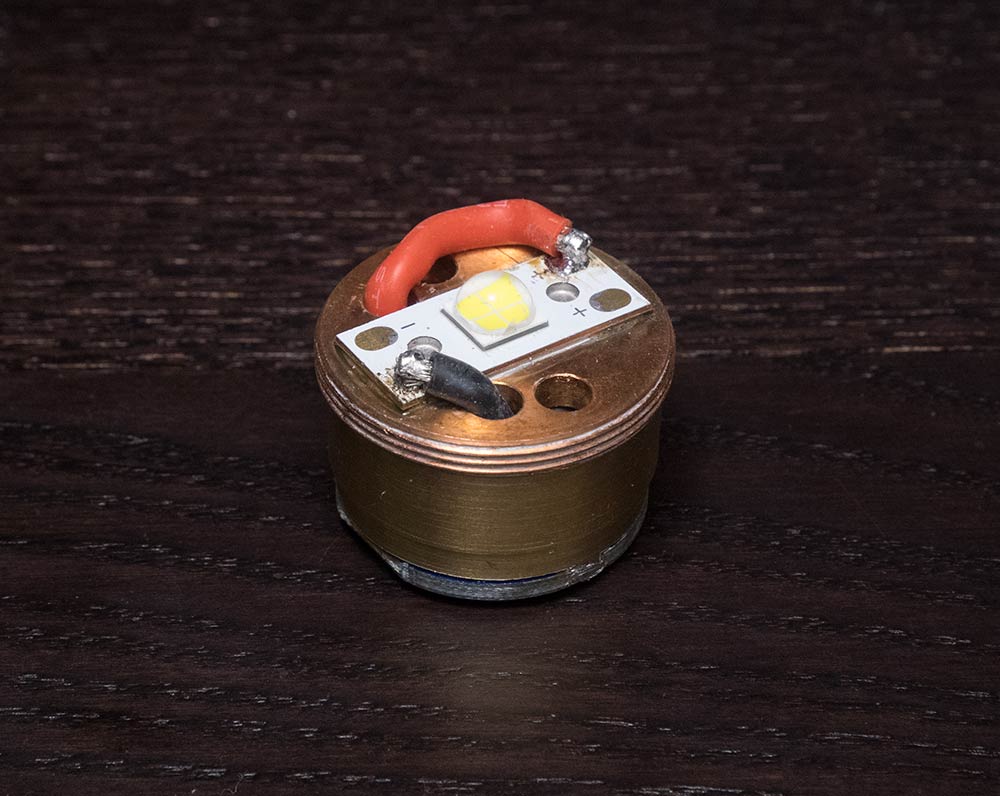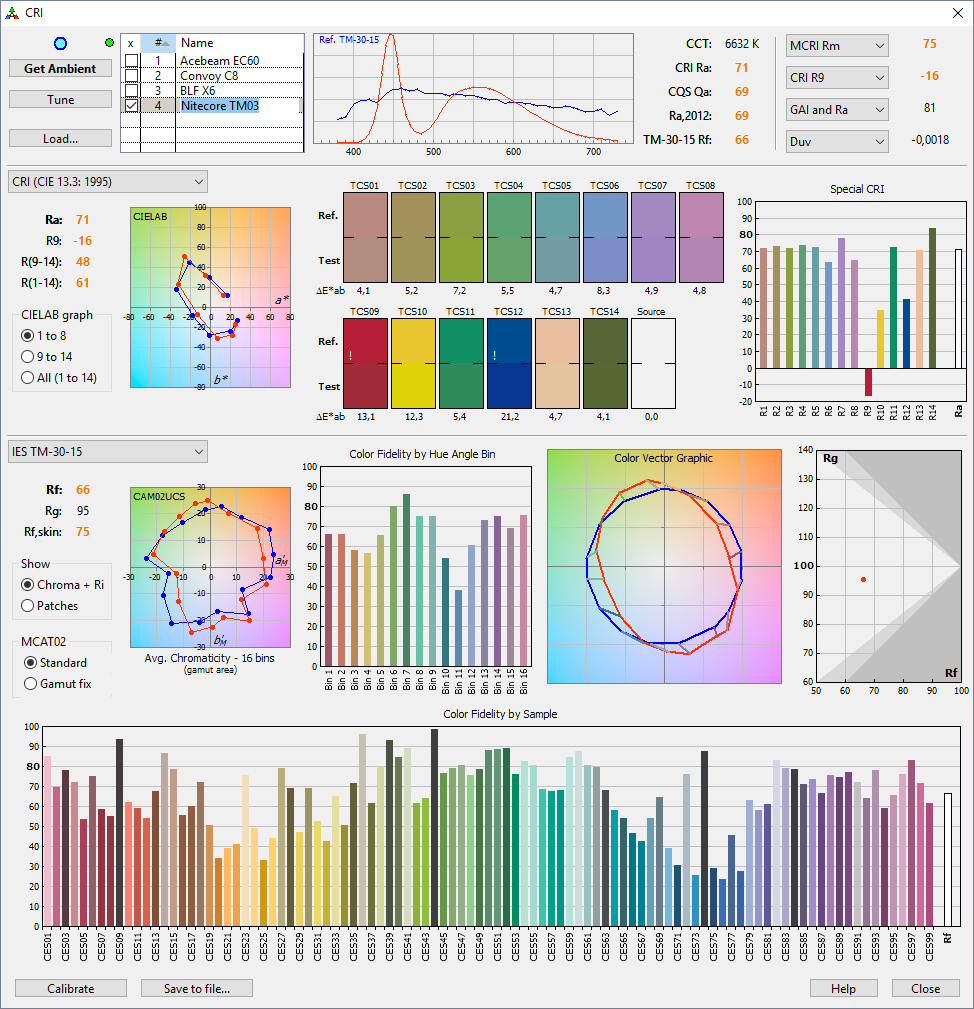NITECORE have been expanding the Tiny Monster line and with the TM03 have shrunk the monster performance into a single 18650 size light. Now it is even easier to carry Tiny Monster performance with you in the form of the world's most powerful 1x 18650 light.
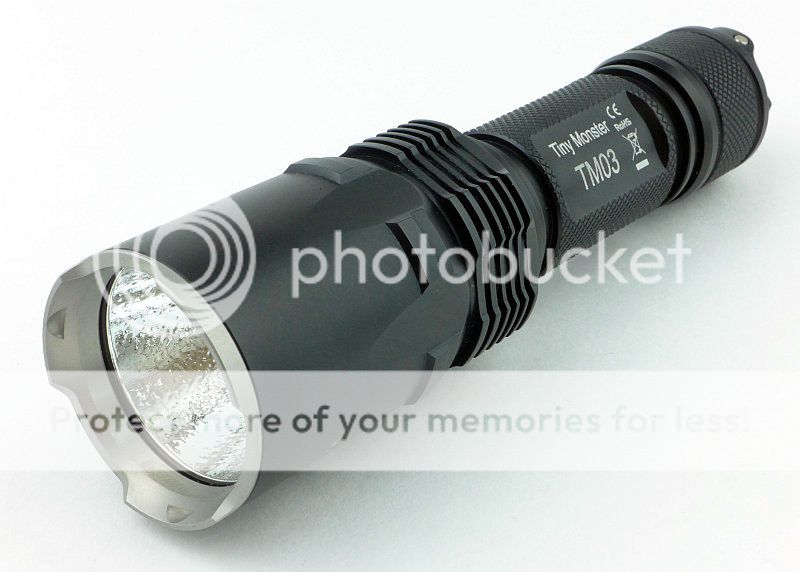
Taking a more detailed look:
Following the other TM series lights, the TM03 comes in a tough cardboard box.

The light is held in place with a strong closed cell foam.

Along with the TM03, a holster, the instructions and a spare o-ring are provided.
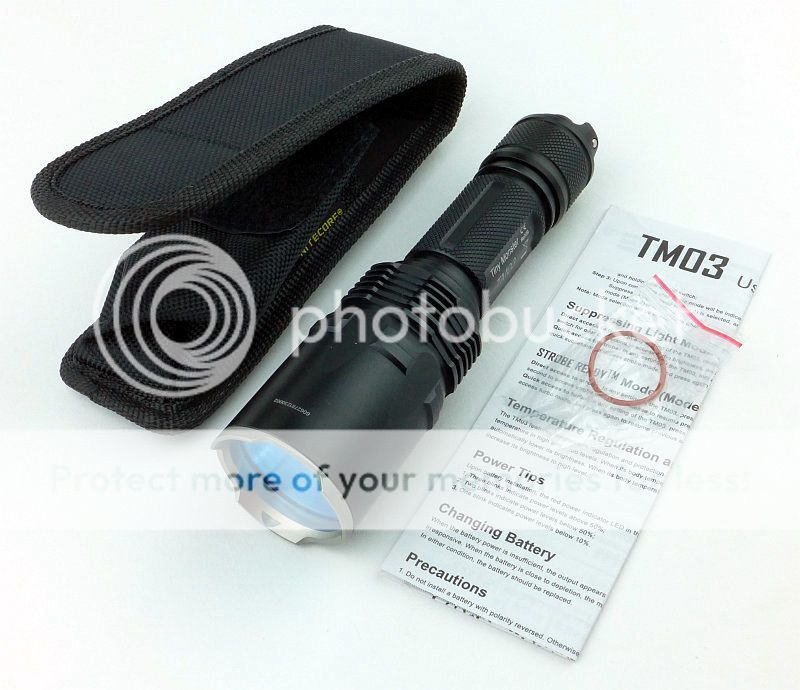
Before we look at the TM03 in more detail, let's look at the holster. Here it is with the TM03 inside.

You have the choice of D-loop, fixed loop, or Velcro loop.

There is a blue plastic lens protector on the front when it arrives. You MUST remove this before trying the TM03 at all as it will melt and make a mess of the lens if you don't.
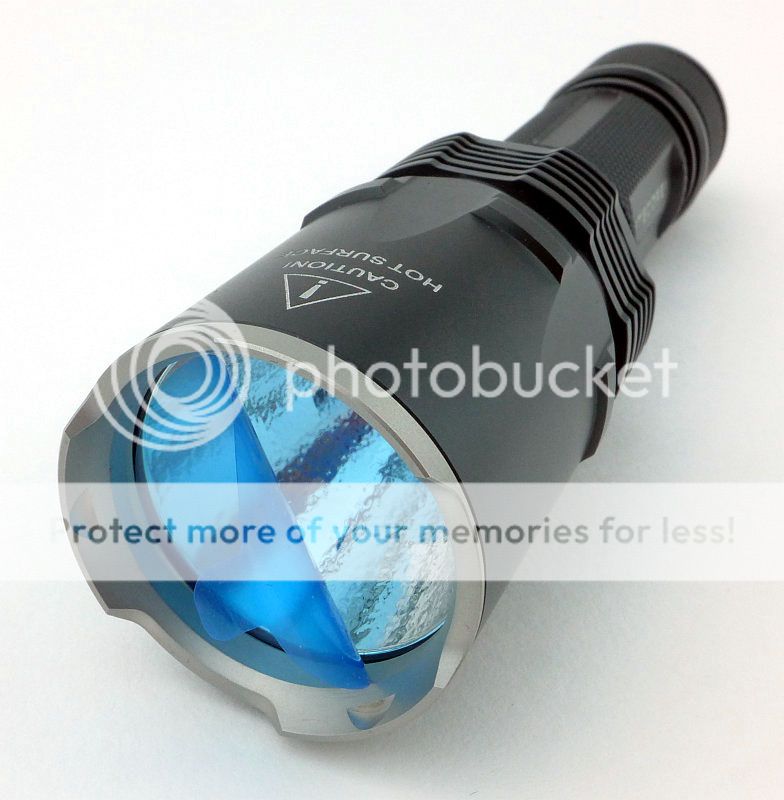
As with the NITECORE Precise series, the TM03 has a dual switch tail-cap. One is a forward clicky standard switch and the other is a metal paddle MODE switch.
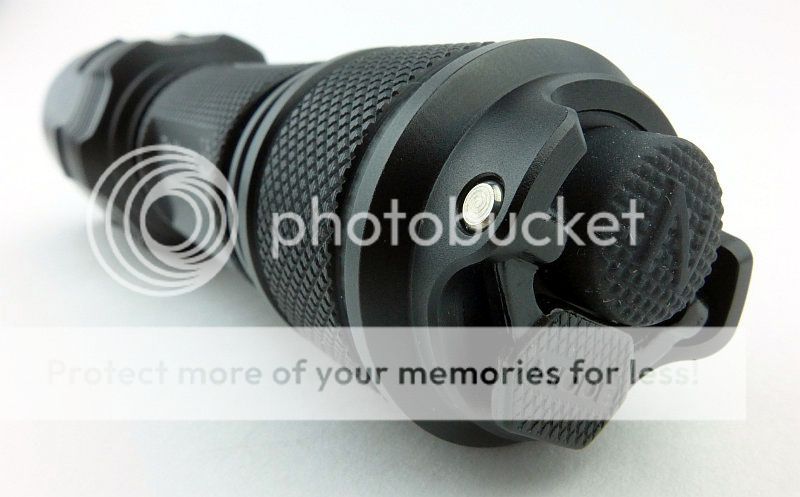
Supplied in the TM03 is a special IMR cell, clearly labelled 'FOR TM03'. It is normal 18650 size, so this gives you and idea of the overall size of the TM03.
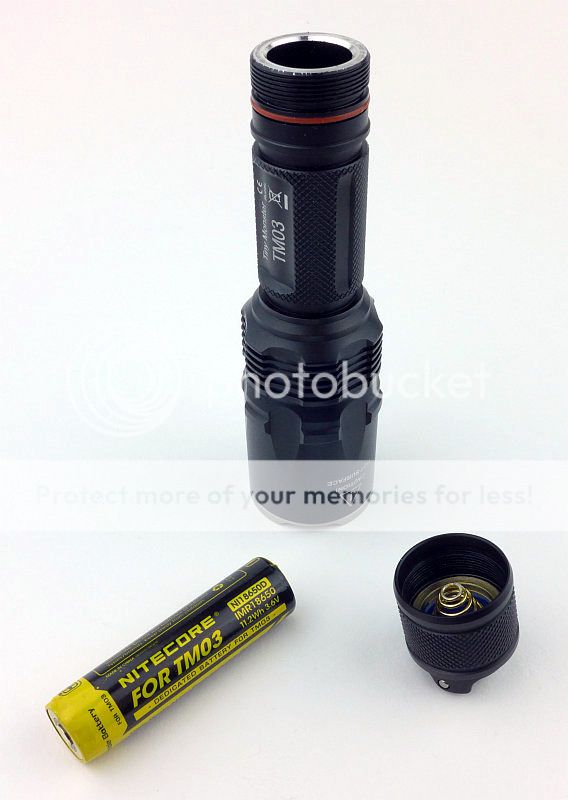
In the tailcap are the two normal contacts.
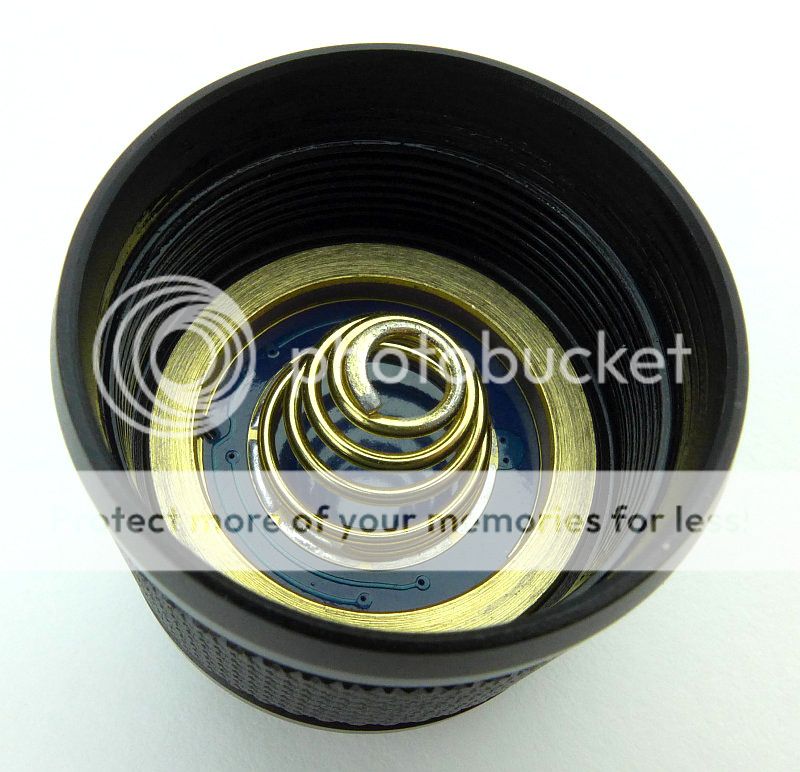
Mainly for heat-sinking, the TM03 has a heavy duty thick walled battery tube.
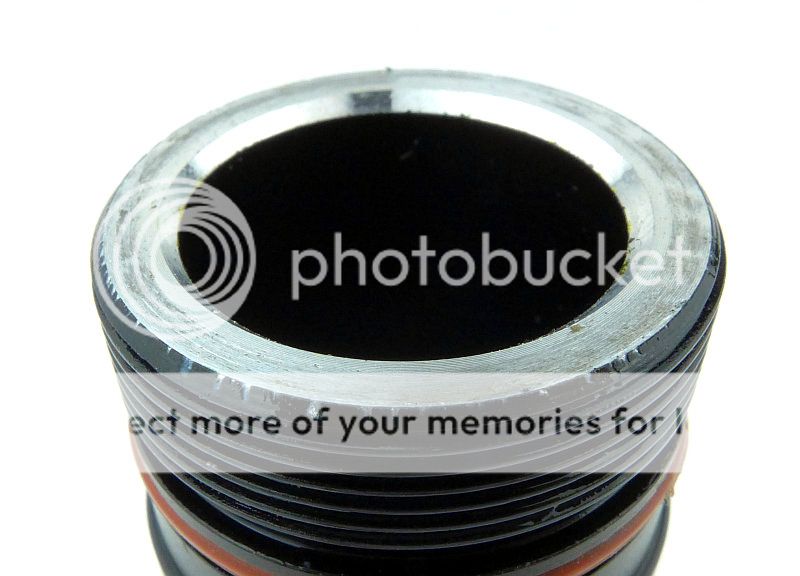
Standard threads are used for the tail-cap.

Back to the dedicated 18650 IMR cell. Notice the dual contacts at the front.
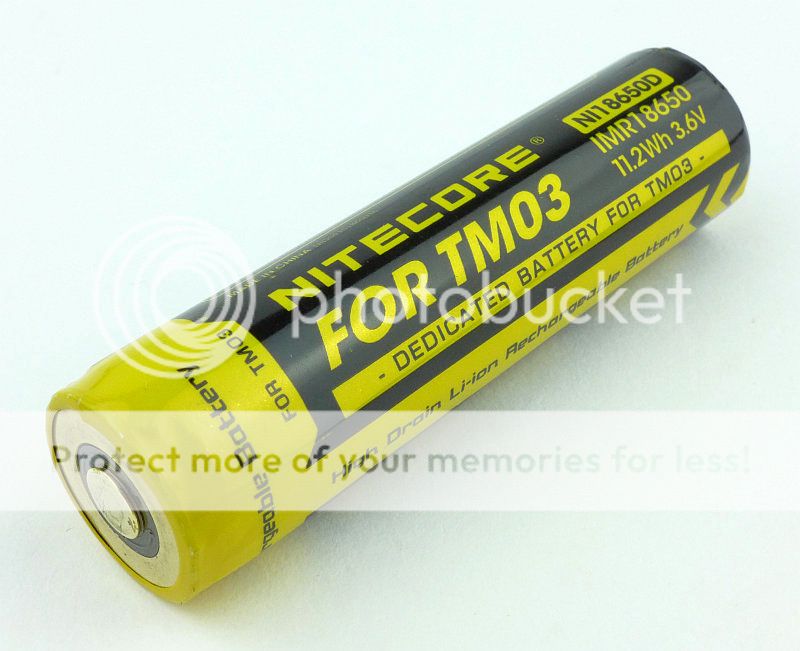
Taking a closer look at the dual contacts on what would normally be the positive end of the cell.
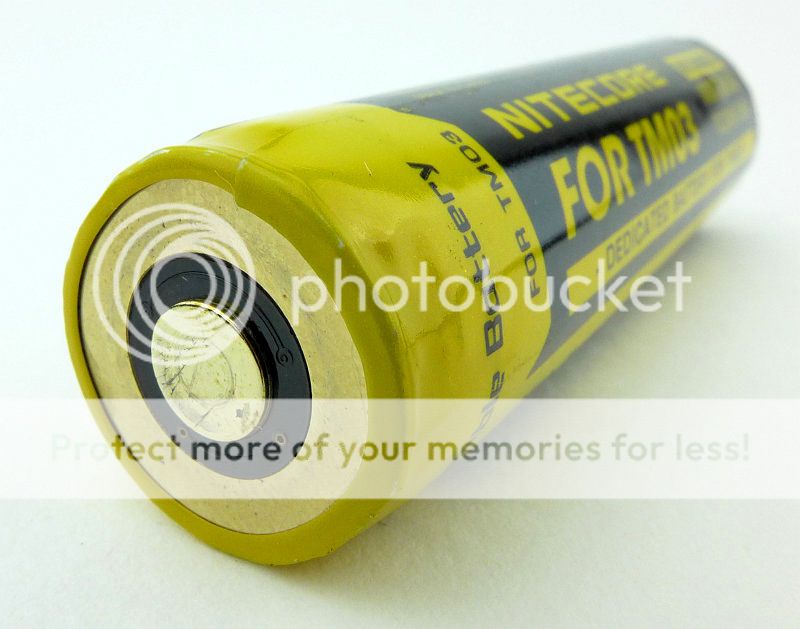
The negative terminal of the cell is standard.
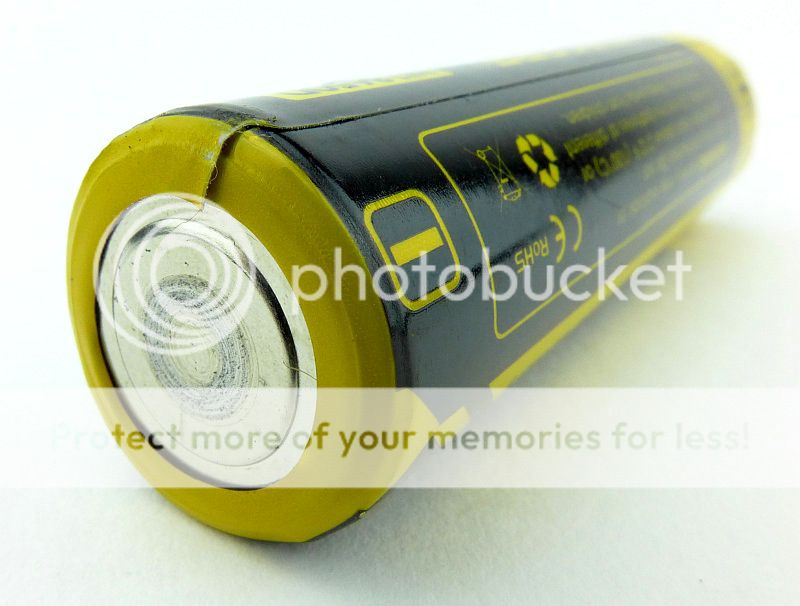
Peering inside the battery tube you can make out the positive contact as well as the secondary contacts surrounding it.
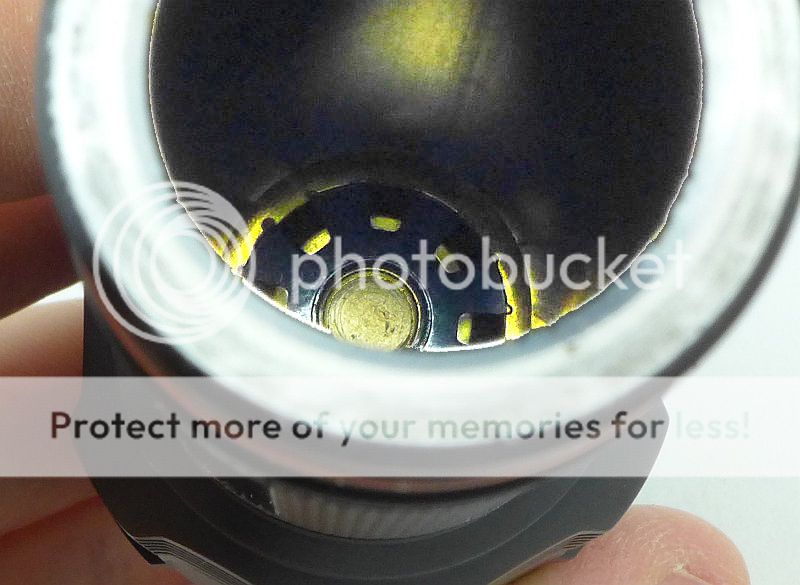
Finish is to a high standard as is the engraving.
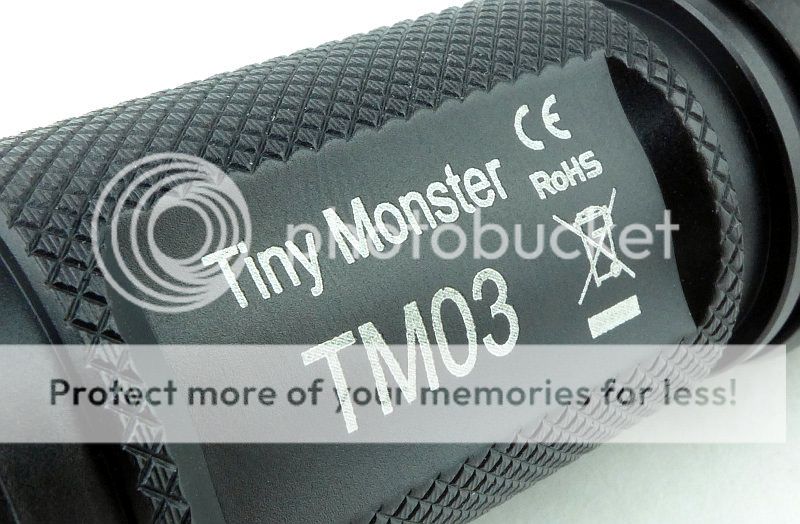
Despite the high output, the cooling fins are shallow.
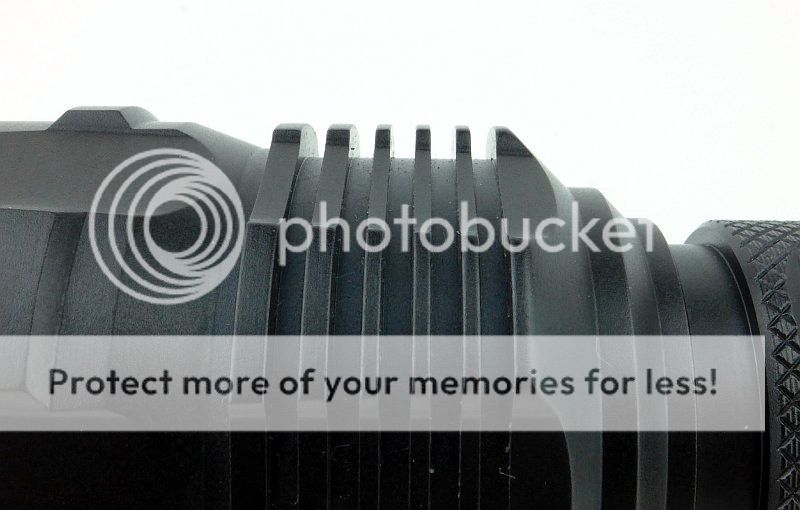
Here is the heart of this Tiny Monster, its monster XHP70 Quad die LED.
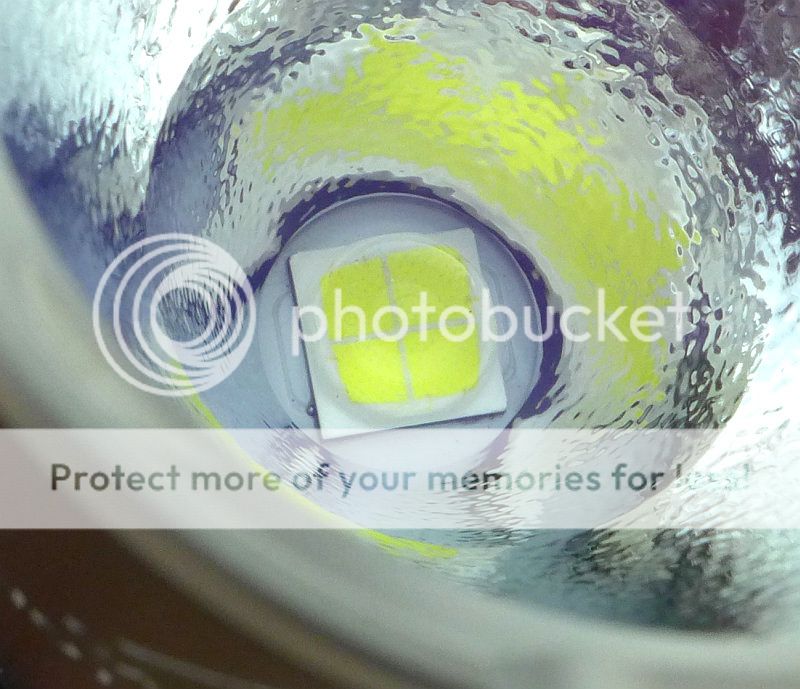
The reflector is textured to give a smoother beam, but the reflector also has two profiles specifically controlling how much spill and hotspot the TM03 has.
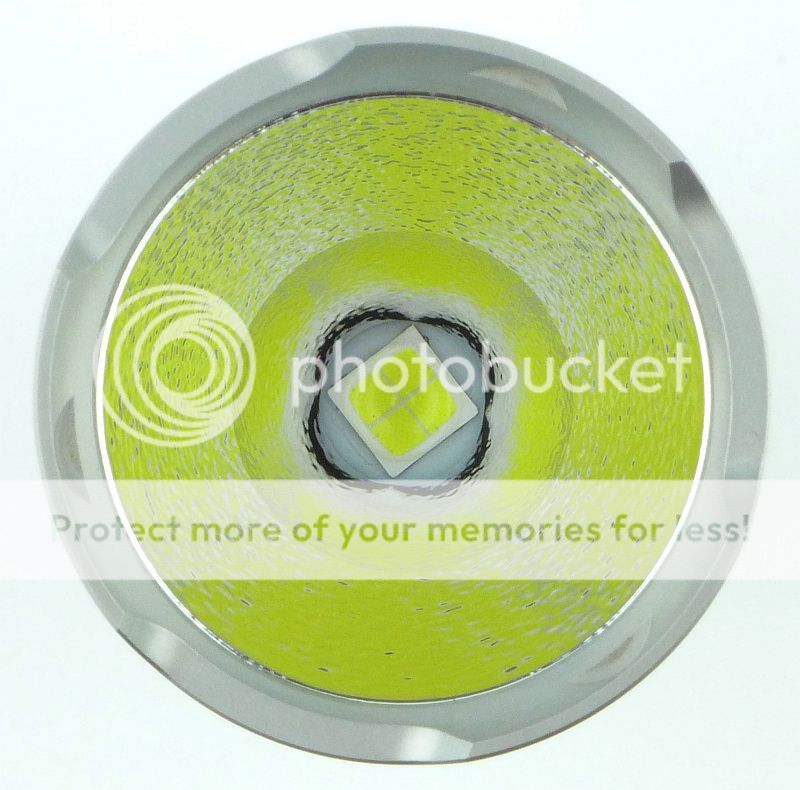
Putting the TM03 next to a normal 18650 light, it is slightly bigger and heavier in build, but has performance that outshines the standard light by a long way.
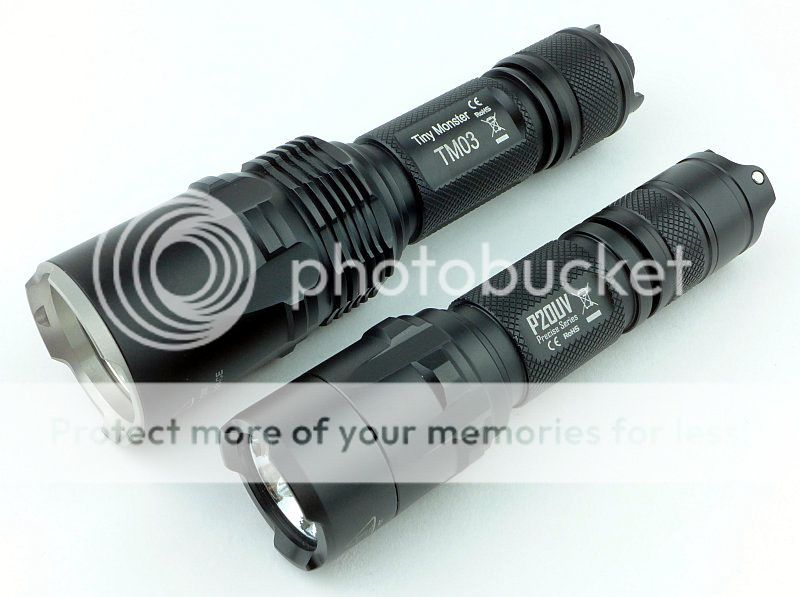
The beam
Please be careful not to judge tint based on images you see on a computer screen. Unless properly calibrated, the screen itself will change the perceived tint.
The indoor beamshot is intended to give an idea of the beam shape/quality rather than tint. All beamshots are taken using daylight white balance. The woodwork (stairs and skirting) are painted Farrow & Ball "Off-White", and the walls are a light sandy colour called 'String' again by Farrow & Ball. I don't actually have a 'white wall' in the house to use for this, and the wife won't have one!
With such high output, and indoor shot can easily be overblown, so this is not a representation of how bright the beam is, but the characteristics of the beam. Exposure has been adjusted to show the hotspot, spill, and outer spill. For such a large LED, there is quite a defined hotspot, and the spill is a medium width.
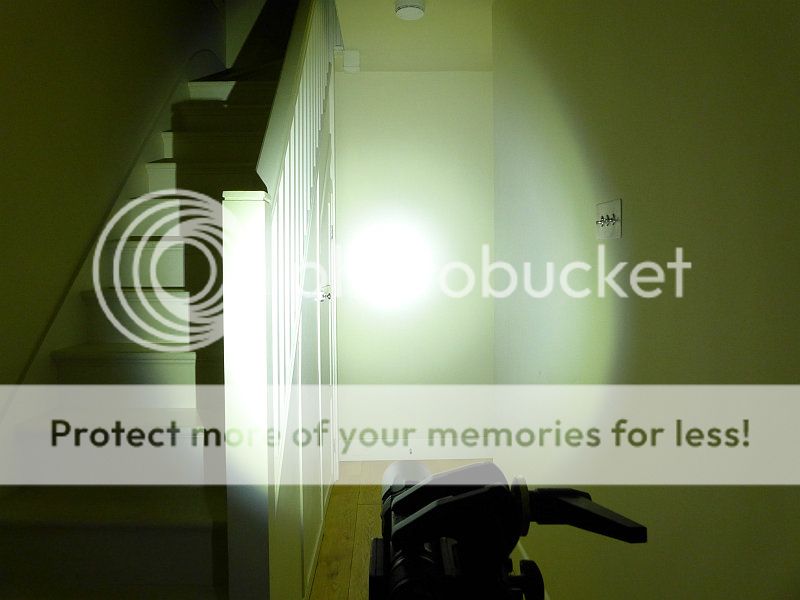
Then we go outdoors...
For the full set of beam-shots, please go to the Exclusive Content at Tactical Reviews , but remember to return to this forum to discuss the review.
Modes and User Interface:
The TM03 has four constant modes (Turbo, High, Mid and Low) and one flashing (Strobe) mode, controlled by a dual-switch tail-cap.
Basic operation is with the forward-clicky switch; half press for momentary access to the last used constant mode, and fully press and click to turn the TM03 ON to the last used constant mode. (Release or click again to switch off).
When ON, pressing the MODE switch cycles through the output modes - Low, Mid, High, Turbo, Low etc.
The TM03 allows you to set up the direct access operation of the MODE switch in two different modes - Suppressing Light, or STROBE READY.
To swap between these two modes:
Switch the TM03 OFF
Remove and replace the battery.
Within 60s of replacing the battery tighten the tail-cap while pressing and holding the MODE switch.
The TM03 will then flash once to indicate Suppressing Light, and two for STROBE READY.
In Suppressing Light mode:
Direct access to Turbo - in any mode including OFF, press and hold the MODE switch. Release to return to previous output.
Quick access to Strobe - in any mode including OFF, press the MODE switch twice in quick succession. Press again to return to previous output.
In STROBE READY mode:
Direct access to Strobe - in any mode including OFF, press and hold the MODE switch. Release to return to previous output.
Quick access to Turbo - in any mode including OFF, press the MODE switch twice in quick succession. Press again to return to previous output.
When inserting the battery, a red light in the tail-cap flashes to indicate battery power. Three blinks for above 50%, two blinks for below 50% and one blink for less than 10%.
Batteries and output:
The TM03 runs on a supplied proprietary IMR call with dual contacts on one end, but will also run at a severely reduced output on a normal 18650.
To measure actual output, I built an integrating sphere. See here for more detail. The sensor registers visible light only (so Infra-Red and Ultra-Violet will not be measured).
Please note, all quoted lumen figures are from a DIY integrating sphere, and according to ANSI standards. Although every effort is made to give as accurate a result as possible, they should be taken as an estimate only. The results can be used to compare outputs in this review and others I have published.
For Detailed output measurements, please go to the Exclusive Content at Tactical Reviews , but remember to return to this forum to discuss the review.
* Beacon and Strobe output measurements are only estimates as the brief flashes make it difficult to capture the actual output value.
Peak Beam intensity measured 21300 lx @1m giving a beam range of 292 m.
There is parasitic drain and due to the dual contact at the head of the light there is drain at the head, and drain at the tailcap. When using the TM03's IMR cell, the drain was 1.7mA at the head and 15uA at the tailcap. Taking the worst of these as the only significant value, it is the head drain that is relevant as it will take only 76 days to drain the cell.
NOTE: The use of the AW IMR cell for the 'normal' 18650 test was to prove that the throttling of output was not due to a bad cell. The TM03 is drastically throttled when not using the supplied cell and this is no reflection on the AW cell.
This graph has three traces on it to show a couple of specific aspects, including comparing a couple of NITECORE chargers, the SC2 and D4 (both used to charge the TM0s's cell), and also showing the characteristics depending on if you start in Turbo or High.
The SC2 is a rapid charger, well suited to IMR cells. Due to charging at a higher current, it also tends to terminate earlier. This can be seen with the earlier drop to low mode at around 1h 20m. Considering the vast reduction in charging time, this minor loss in overall output is well worth it.
Then look at the overall characteristics when starting on Turbo where after the initial 2800lm burst, the output drops right down to the 630lm Mid level output, and then continues on this until the cell is depleted.
When starting on High, the output remains on High until the cell can no longer maintain the output and starts to drop in stages, gradually reducing at 20m all the way through to 1h from turn on.
Effectively if you want more light for longer, either stay on High, or you'll have to switch it OFF and ON again to get Turbo (as long as it is not too hot), and expect not to have much runtime.
For the runtime graph, please go to the Exclusive Content at Tactical Reviews , but remember to return to this forum to discuss the review.
Troubleshooting
This section is included to mention any minor niggles I come across during testing, in case the information helps anyone else.
No issues were encountered during testing.
As per the description of this section, this information is provided in case anyone else finds a similar 'issue' that might be fixed in the same way.
The TM03 in use
Normally I don't like to start with a negative, but the TM03 does have one issue, and that is particularly with the Suppression Mode. I have found that when closing the holster flap over the TM03's tail-cap, it is easy to press (or more dangerously - nearly press) the MODE switch enough to activate direct access Turbo. This means that inside the holster the TM03 bursts into life with all 2800lm. It gets hot VERY fast. Now I also said 'more dangerously - nearly press', and the reason it is more dangerous, is that the TM03 is now on a hair trigger needing only a tiny pressure on the holster to bring on the Turbo output. I was putting the TM03 into a drawer and as it nestled against some other items Turbo came on. Luckily I noticed, but I could easily have closed that drawer - for the last time.
So my first comment is that if using the holster you need to undo the tail-cap a half turn (a quarter is not enough) to lock-out the TM03.
Now onto the good stuff. This is a very bright light. Even these days when people are used to high output lights, the TM03 still surprises with its compact size. It is not much bigger than standard 1x 18650 lights, but is a lot more powerful. The heavy build is reassuring and is certainly needed for heat-sinking. I never had the sense the TM03 was getting too hot.
My own views on tactical lighting requirements gathered from various members of the armed services and law enforcement are that Strobe is not the preferred output, but very bright is. The TM03 does VERY bright, very well.
Of course with the fundamental law of portable lighting that you can only have two of the three factors - Bright, Small, Long Runtime, the TM03 looses out in runtime. Mainly this is because if you have the TM03 on you, why would you bother with the Low mode? You will be enjoying all those lumens, using bursts of Turbo, and all too soon it does start to struggle. Not the fault of the TM03, but just a factor to be aware of - this is a Tiny Monster after all.
It was worth the extra effort required to check the parasitic drain at the head, as this explains why after only short periods of storage, the runtime is even more reduced. This level of drain is bad. It is easy to pop a light in a drawer for three months at a time, and in that time the TM03 will be dead. Even if you undo the tail-cap slightly, this doesn't stop the double pole in the head making contact and draining the cell, you need to remove the cell completely.
With regard to using other 18650 cells, NITECORE have severely hobbled the output on the TM03 when not using its dedicated double pole IMR. The maximum output I managed to get was around 250lm. It does mean that you know you can still have enough light to see by if you carry a normal 18650 as a spare, but once that dedicated IMR is depleted, you need to recharge before you get the TM performance again. At least you know it will work as a backup, and with such extreme performance it is sensible to protect the light and the user from 'unknown' cells.
If you want a pocket rocket, the TM03 will not disappoint, and brings custom level performance to a production light.
Review Summary

---------------------------------------------------------------------------------------------------------------------
Author's Statement for Transparency and Disclosure
The test sample/s featured in this article have been provided for technical testing and review by the manufacturer. Test samples are retained by the reviewer following publication of the completed review for the purposes of long term testing and product comparisons.
All output figures and test results published in this review are the sole work of the reviewer, and are carried out independently and without bias. Test results are reported as found, with no embellishments or alteration. Though best endeavours are made to maintain the accuracy of test equipment, the accuracy of these results is not guaranteed and is subject to the test equipment functioning correctly.
----------------------------------------------------------------------------------------------------------------------
Author's Statement for Transparency and Disclosure
The test sample/s featured in this article have been provided for technical testing and review by the manufacturer. Test samples are retained by the reviewer following publication of the completed review for the purposes of long term testing and product comparisons.
All output figures and test results published in this review are the sole work of the reviewer, and are carried out independently and without bias. Test results are reported as found, with no embellishments or alteration. Though best endeavours are made to maintain the accuracy of test equipment, the accuracy of these results is not guaranteed and is subject to the test equipment functioning correctly.
----------------------------------------------------------------------------------------------------------------------
Taking a more detailed look:
Following the other TM series lights, the TM03 comes in a tough cardboard box.

The light is held in place with a strong closed cell foam.

Along with the TM03, a holster, the instructions and a spare o-ring are provided.

Before we look at the TM03 in more detail, let's look at the holster. Here it is with the TM03 inside.

You have the choice of D-loop, fixed loop, or Velcro loop.

There is a blue plastic lens protector on the front when it arrives. You MUST remove this before trying the TM03 at all as it will melt and make a mess of the lens if you don't.

As with the NITECORE Precise series, the TM03 has a dual switch tail-cap. One is a forward clicky standard switch and the other is a metal paddle MODE switch.

Supplied in the TM03 is a special IMR cell, clearly labelled 'FOR TM03'. It is normal 18650 size, so this gives you and idea of the overall size of the TM03.

In the tailcap are the two normal contacts.

Mainly for heat-sinking, the TM03 has a heavy duty thick walled battery tube.

Standard threads are used for the tail-cap.

Back to the dedicated 18650 IMR cell. Notice the dual contacts at the front.

Taking a closer look at the dual contacts on what would normally be the positive end of the cell.

The negative terminal of the cell is standard.

Peering inside the battery tube you can make out the positive contact as well as the secondary contacts surrounding it.

Finish is to a high standard as is the engraving.

Despite the high output, the cooling fins are shallow.

Here is the heart of this Tiny Monster, its monster XHP70 Quad die LED.

The reflector is textured to give a smoother beam, but the reflector also has two profiles specifically controlling how much spill and hotspot the TM03 has.

Putting the TM03 next to a normal 18650 light, it is slightly bigger and heavier in build, but has performance that outshines the standard light by a long way.

The beam
Please be careful not to judge tint based on images you see on a computer screen. Unless properly calibrated, the screen itself will change the perceived tint.
The indoor beamshot is intended to give an idea of the beam shape/quality rather than tint. All beamshots are taken using daylight white balance. The woodwork (stairs and skirting) are painted Farrow & Ball "Off-White", and the walls are a light sandy colour called 'String' again by Farrow & Ball. I don't actually have a 'white wall' in the house to use for this, and the wife won't have one!
With such high output, and indoor shot can easily be overblown, so this is not a representation of how bright the beam is, but the characteristics of the beam. Exposure has been adjusted to show the hotspot, spill, and outer spill. For such a large LED, there is quite a defined hotspot, and the spill is a medium width.

Then we go outdoors...
For the full set of beam-shots, please go to the Exclusive Content at Tactical Reviews , but remember to return to this forum to discuss the review.
Modes and User Interface:
The TM03 has four constant modes (Turbo, High, Mid and Low) and one flashing (Strobe) mode, controlled by a dual-switch tail-cap.
Basic operation is with the forward-clicky switch; half press for momentary access to the last used constant mode, and fully press and click to turn the TM03 ON to the last used constant mode. (Release or click again to switch off).
When ON, pressing the MODE switch cycles through the output modes - Low, Mid, High, Turbo, Low etc.
The TM03 allows you to set up the direct access operation of the MODE switch in two different modes - Suppressing Light, or STROBE READY.
To swap between these two modes:
Switch the TM03 OFF
Remove and replace the battery.
Within 60s of replacing the battery tighten the tail-cap while pressing and holding the MODE switch.
The TM03 will then flash once to indicate Suppressing Light, and two for STROBE READY.
In Suppressing Light mode:
Direct access to Turbo - in any mode including OFF, press and hold the MODE switch. Release to return to previous output.
Quick access to Strobe - in any mode including OFF, press the MODE switch twice in quick succession. Press again to return to previous output.
In STROBE READY mode:
Direct access to Strobe - in any mode including OFF, press and hold the MODE switch. Release to return to previous output.
Quick access to Turbo - in any mode including OFF, press the MODE switch twice in quick succession. Press again to return to previous output.
When inserting the battery, a red light in the tail-cap flashes to indicate battery power. Three blinks for above 50%, two blinks for below 50% and one blink for less than 10%.
Batteries and output:
The TM03 runs on a supplied proprietary IMR call with dual contacts on one end, but will also run at a severely reduced output on a normal 18650.
To measure actual output, I built an integrating sphere. See here for more detail. The sensor registers visible light only (so Infra-Red and Ultra-Violet will not be measured).
Please note, all quoted lumen figures are from a DIY integrating sphere, and according to ANSI standards. Although every effort is made to give as accurate a result as possible, they should be taken as an estimate only. The results can be used to compare outputs in this review and others I have published.
For Detailed output measurements, please go to the Exclusive Content at Tactical Reviews , but remember to return to this forum to discuss the review.
* Beacon and Strobe output measurements are only estimates as the brief flashes make it difficult to capture the actual output value.
Peak Beam intensity measured 21300 lx @1m giving a beam range of 292 m.
There is parasitic drain and due to the dual contact at the head of the light there is drain at the head, and drain at the tailcap. When using the TM03's IMR cell, the drain was 1.7mA at the head and 15uA at the tailcap. Taking the worst of these as the only significant value, it is the head drain that is relevant as it will take only 76 days to drain the cell.
NOTE: The use of the AW IMR cell for the 'normal' 18650 test was to prove that the throttling of output was not due to a bad cell. The TM03 is drastically throttled when not using the supplied cell and this is no reflection on the AW cell.
This graph has three traces on it to show a couple of specific aspects, including comparing a couple of NITECORE chargers, the SC2 and D4 (both used to charge the TM0s's cell), and also showing the characteristics depending on if you start in Turbo or High.
The SC2 is a rapid charger, well suited to IMR cells. Due to charging at a higher current, it also tends to terminate earlier. This can be seen with the earlier drop to low mode at around 1h 20m. Considering the vast reduction in charging time, this minor loss in overall output is well worth it.
Then look at the overall characteristics when starting on Turbo where after the initial 2800lm burst, the output drops right down to the 630lm Mid level output, and then continues on this until the cell is depleted.
When starting on High, the output remains on High until the cell can no longer maintain the output and starts to drop in stages, gradually reducing at 20m all the way through to 1h from turn on.
Effectively if you want more light for longer, either stay on High, or you'll have to switch it OFF and ON again to get Turbo (as long as it is not too hot), and expect not to have much runtime.
For the runtime graph, please go to the Exclusive Content at Tactical Reviews , but remember to return to this forum to discuss the review.
Troubleshooting
This section is included to mention any minor niggles I come across during testing, in case the information helps anyone else.
No issues were encountered during testing.
As per the description of this section, this information is provided in case anyone else finds a similar 'issue' that might be fixed in the same way.
The TM03 in use
Normally I don't like to start with a negative, but the TM03 does have one issue, and that is particularly with the Suppression Mode. I have found that when closing the holster flap over the TM03's tail-cap, it is easy to press (or more dangerously - nearly press) the MODE switch enough to activate direct access Turbo. This means that inside the holster the TM03 bursts into life with all 2800lm. It gets hot VERY fast. Now I also said 'more dangerously - nearly press', and the reason it is more dangerous, is that the TM03 is now on a hair trigger needing only a tiny pressure on the holster to bring on the Turbo output. I was putting the TM03 into a drawer and as it nestled against some other items Turbo came on. Luckily I noticed, but I could easily have closed that drawer - for the last time.
So my first comment is that if using the holster you need to undo the tail-cap a half turn (a quarter is not enough) to lock-out the TM03.
Now onto the good stuff. This is a very bright light. Even these days when people are used to high output lights, the TM03 still surprises with its compact size. It is not much bigger than standard 1x 18650 lights, but is a lot more powerful. The heavy build is reassuring and is certainly needed for heat-sinking. I never had the sense the TM03 was getting too hot.
My own views on tactical lighting requirements gathered from various members of the armed services and law enforcement are that Strobe is not the preferred output, but very bright is. The TM03 does VERY bright, very well.
Of course with the fundamental law of portable lighting that you can only have two of the three factors - Bright, Small, Long Runtime, the TM03 looses out in runtime. Mainly this is because if you have the TM03 on you, why would you bother with the Low mode? You will be enjoying all those lumens, using bursts of Turbo, and all too soon it does start to struggle. Not the fault of the TM03, but just a factor to be aware of - this is a Tiny Monster after all.
It was worth the extra effort required to check the parasitic drain at the head, as this explains why after only short periods of storage, the runtime is even more reduced. This level of drain is bad. It is easy to pop a light in a drawer for three months at a time, and in that time the TM03 will be dead. Even if you undo the tail-cap slightly, this doesn't stop the double pole in the head making contact and draining the cell, you need to remove the cell completely.
With regard to using other 18650 cells, NITECORE have severely hobbled the output on the TM03 when not using its dedicated double pole IMR. The maximum output I managed to get was around 250lm. It does mean that you know you can still have enough light to see by if you carry a normal 18650 as a spare, but once that dedicated IMR is depleted, you need to recharge before you get the TM performance again. At least you know it will work as a backup, and with such extreme performance it is sensible to protect the light and the user from 'unknown' cells.
If you want a pocket rocket, the TM03 will not disappoint, and brings custom level performance to a production light.
Review Summary
| _______________________________________________ | _______________________________________________ |
| Things I like | What doesn't work so well for me |
| _______________________________________________ | _______________________________________________ |
| 2800lm on a single 18650!! | Direct access via the MODE switch too easily activated by the holster flap. |
| Solid build. | High Parasitic Drain. |
| Direct access to TURBO. | Uses a proprietary cell for full performance. |
| Sturdy holster provided. | |
| Supplied with cell so you only need a charger. |


